The Sky This Month Nov-Dec 2017
Morning planets include Venus and Jupiter; catch Mercury and Saturn at dusk. The Moon will not interfere with the Leonid meteor shower this year. Try for Lunar X and the Straight Wall near First Quarter. Many deep sky objects await in Camelopardalis, Taurus, Perseus, and Aries. Go low in the constellations Fornax and Columba. Watch the skies!
Blake Nancarrow delivered the following The Sky This Month presentation at the 15 November 2017 Recreational Astronomy Night meeting at the Ontario Science Centre. He prepared his usual month-at-a-glance calendar covering the balance of November and the first weeks of December 2017. You may view or download and print the colour calendar PDF file (~390 KB).
Cover photograph of the Moon and Venus at dawn by Malcolm Park. Used with permission.
All photos copyright the respective owners.
If you are working on a general or RASC observing certificate, we include targets on the Explore The Universe, Messier, Finest NGCs, and Herschel 400.
observing lists
The suggested targets for this TSTM have been formatted in observing lists for popular astronomy software. You may download a file and install it in your device or computer so to have a list of suggestions when at the telescope.
- SkySafari: TSTM1711.skylist, 6 KB, text
- SkyTools: TSTM1711.stx, 7 KB, binary
- Excel: TSTM1711.xls, 42 KB, binary
Note: Files stored on Blake's web site under the Computer Ease domain.
our local variable star
The Sun is surprisingly active. This is curious as Sol is in its low phase of activity. The Sun exhibits of cycle of 9 to 14 years and on average every 11 years peaks. During "solar maximum" there are many sunspots, flares, and prominences with increased auroral activity at the Earth. Currently we are between peaks but still we experience numerous, random significant flares, long-lived sunspots, and strong aurora sightings (as recent as 12 October).
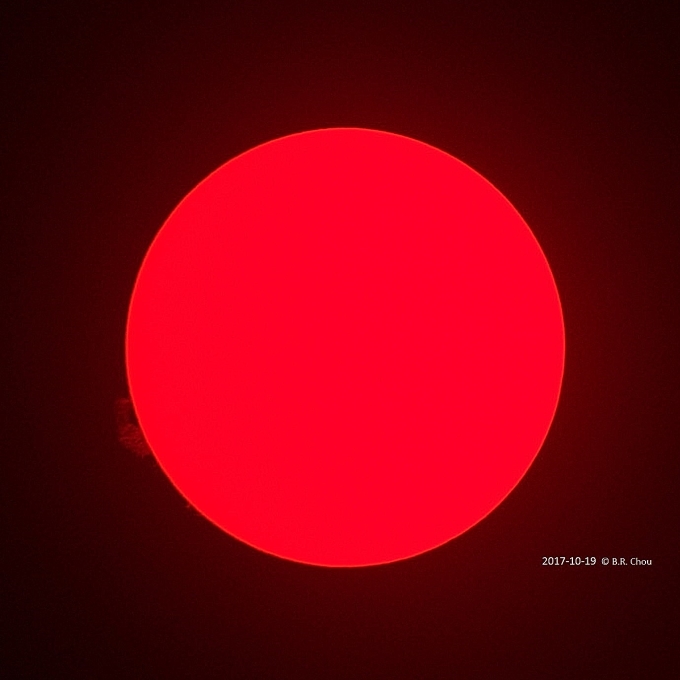
Sun with large prominence. Photograph by Dr B Ralph Chou.
Don't like winter? You can observe or image for over 10 hours. Astronomical twilight represents the period when the Sun is between 12 and 18 degrees below the horizon. Once lower than 18, the night sky is as dark as it can be.
| Sunset | Astronomical Twilight End |
Astro Twilight Begins |
Sunrise | Hours of Darkness |
|
| 15 Nov | 16:58 | 18:35 | 05:38 | 07:15 | 10.5 |
| 15 Dec | 16:47 | 18:28 | 06:06 | 07:47 | 11.5 |
All times approximate.
There are many web sites and apps you can use to monitor solar activity. Check out the SolarHam web site.
our satellite
We will experience a new Moon on 18 November with the First Quarter occurring on 26 Nov. The Moon will be full on 3 Dec.
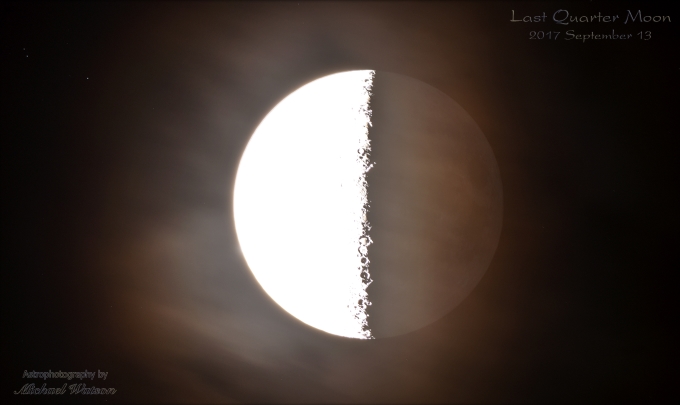
Luna during a Quarter Phase. Photograph by Michael Watson.
There will be an opportunity to see (or photograph) the Lunar X phenomenon the night before First Quarter while examining the "Railroad" or "Straight Wall" on 26 Nov. The letter X appears, with a small telescope, near the terminator of light and shadow due to the arrangement of lunar crater walls. Look near Blanchinus, La Caille, and Purbach. The Lunar Railroad is located in Mare Nubium. It is a fault line in the Moon's surface that casts an unusually straight shadow.
Fortunately, the Moon will not interfere with the Leonid meteor shower this year.
planets at dusk and dawn
Mercury and Saturn are visible around dusk.
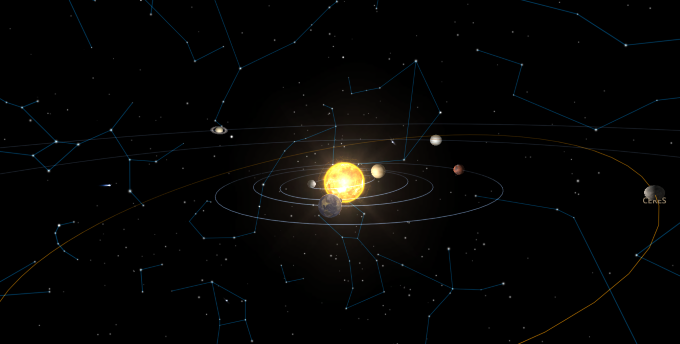
Planet positions as of 15 Nov, 11:00 PM. Graphic by Solar System Scope.
Mercury is left or east of the Sun and therefore visible in the evening sky. It can be viewed with the unaided eye although it is often helpful and quick to first use binoculars. It can be tricky when the sky is glowing from the setting Sun and that the planet is star-like. On 24 Nov, the inner-most planet is furthest from the Sun, that is, it is at maximum angular separation or "greatest elongation." This is a good time to try. It may be easier to locate the tiny planet a couple of days before. Mercury is near the Moon on 19 and 20 Nov. All that said, the small planet is below the plane of planets (inclined) at this time which places it lower, closer to our horizon.
Saturn is leaving our skies for a time as it goes behind the Sun. More correctly, our rapidly orbiting home world is moving in such a way to put the Sun between us and Saturn. These next few weeks may be your last good chances to view the ringed planet, until spring 2018.
Being west of the Sun, Venus, Jupiter, and Mars are visible before and during dawn for the early-birds. Venus appears to be drawing closer to the Sun. An old thin Moon will be near the bright planet on 17 Nov.
blue planets
Neptune and Uranus are visible in the early and late evening time.
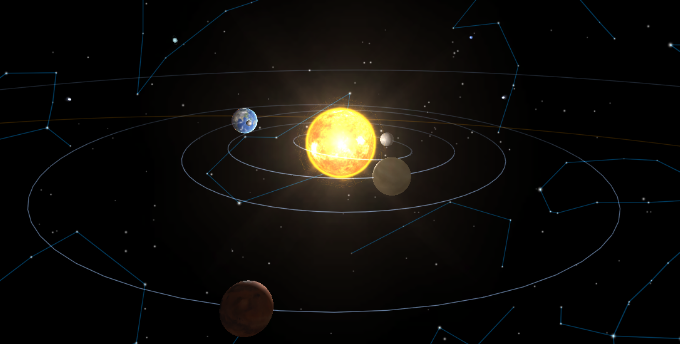
Planet positions as of 15 Nov, 11:00 PM. Graphic by Solar System Scope.
Uranus is well viewed in Pisces, at the bottom of the deep V. It's near the star omicron Piscium. The seventh planet in the solar system can be spotted naked eye but you'll need a dark site and good conditions. And you'll need to be deeply dark-adapted. The brightness of Uranus is magnitude 5.7 all month and this is at the edge of visibility for some. Perhaps challenging with old eyes.
The pale blue planet was opposite the Sun recently, putting it at 19 astronomical units (AU) from planet Earth (AU is the Earth-Sun distance or 150 million km). When this happens, it improves our chances of viewing it without aid, it means we might catch surface features in photographs, and we can better see its moons. Titania and Oberon are the brightest moons, magnitude 13.9 and 14.1, respectively, and you should be able to see them in a medium-sized amateur telescope. Ariel is dimmer, 14.4, closer to the planet, and thus more challenging. Umbriel at mag 15.0 and Miranda at 16.5 are extremely difficult or impossible to see.

Good times to try for the faint satellites are during their elongations from the host planet. It may sound strange but Uranus will create glare which can block one's view of pin-point moons. Dates of night-time elongations are noted below.
- Titania - 20 Nov, 3 Dec
- Oberon - 10 Dec
- Ariel - 16 Nov, 21 Nov, 25 Nov, 26 Nov, 30 Nov, 1 Dec, 5 Dec, 6 Dec, 10 Dec
10 Dec is an especially good night as Oberon and Ariel will be well away from Uranus.
Neptune with its dark blue cast is best viewed in early evening. It is currently in Aquarius, near the lambda star. Given it is at mag 7.9, you will need at least binoculars to spot it. Remarkably, even though the eight planet is much further away from us, at 29 AU, it's brighter moon (13.5) Triton can be seen with greater ease. Still, if having trouble, look during an elongation. One occurs on 17 Nov.
Think those planets are far away? Minor planet Sedna also known as Kuiper Belt Object 90377 will be at opposition on 19 Nov. A mere 84 AU away. You'll probably need a big instrument (and sensitive camera) to tag this one. It clocks in at magnitude 21.
small and fast
Very recently, with little warning, an object was spotted speeding toward our solar system. It has since been designated as A/2017 U1 and was measured at 400 meters. It was moving fairly fast, around 26 km per second. That's similar to Earth’s orbital speed. When the University of Hawaii’s Pan-STARRS telescope found the object, some thought it a comet; but as it drew close to the Sun and never sprouted a tail it was classed as an asteroid. It went inside Mercury's orbit and made a hairpin turn in the gravity well. It then passed the Earth on 14 Oct at a distance of 24 million km. That's about 60 times the Earth-Moon distance (60 LD). The most peculiar thing about A/2017 U1 is that it does not appear to have come from our solar system! This represents our first known interstellar wanderer.
See the article at EarthSky for more information.
UPDATE: This object has received a new designation: 1I (digit one, capital letter i). Meaning, the first interstellar object.
On a cosmological scale, that was a near miss. Still 60 LD leaves some breathing room. Space is big. On 17 Nov, the potentially hazardous asteroid (PHA) 444584 will pass near Earth at 9 LD! Much closer. While going slower (15 km/s) it is about the same size, at 324 m. Imagine a rock falling out of the sky 2 to 3 times the size of the SkyDome. It would leave a dent, to be sure.
Monitor the SpaceWeather web site for potential planet killers.
Mind you, the Chicxulub crater in the Yucatán Peninsula was created by an object estimated to be 10 to 15 km in size. You may recall that one killed most of the dinosaurs.
For a current listing of visible comets, examine the Comet Chasing page at Skyhound.com.
Oh. Nibiru will not destroy the Earth this month.
peek-a-boo
Asteroids far out in the solar system can be measured and sized by monitoring occultations, as the asteroid blocks the light of a star. The following events have rank values over 90%, involve mag 11-12 stars, and dim or block the starlight for 3 seconds or more.
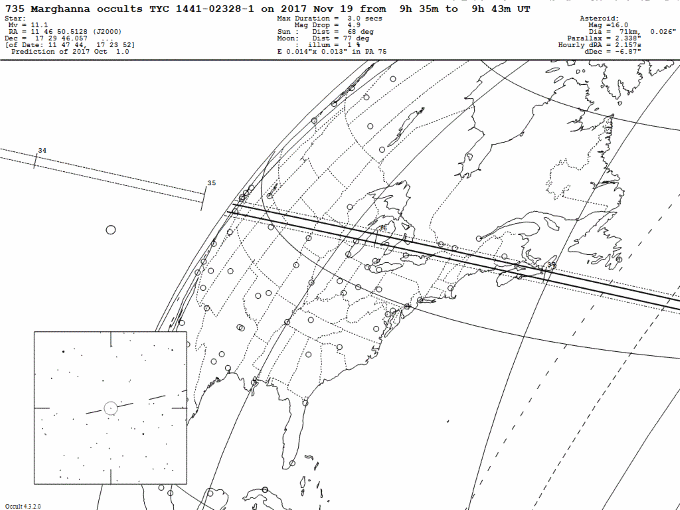
Marghanna's shadow will pass over the Carr Astronomical Observatory (CAO) very late on Saturday 18 Nov or terribly early Sunday 19 Nov morning.
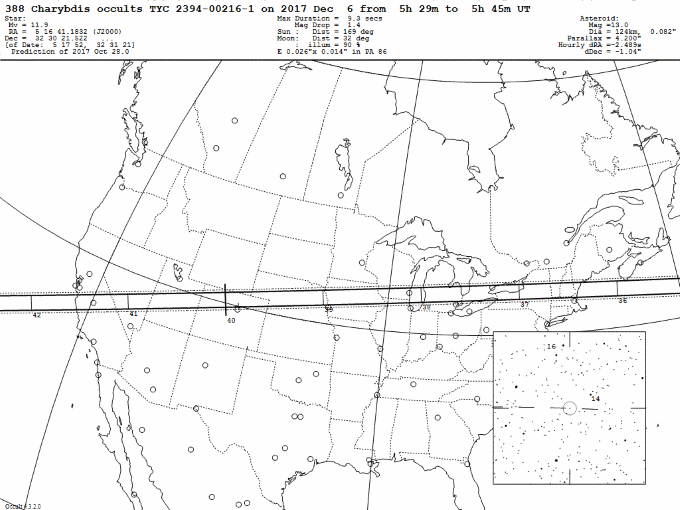
The Charybdis path will go over Toronto at a reasonable time, midnight 5-6 Dec. A backyard target, perhaps?
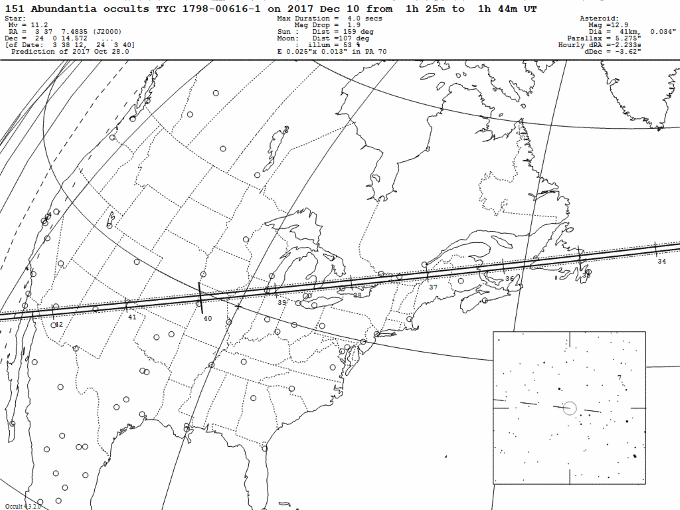
The Abundantia rock will cast its shadow over Richmond Hill on 9 Dec.
Visit the Asteroid Occultation Updates page for more information.
more stuff from outer space
Actually, the Earth is regularly bombarded with material from outer space. It is estimated that 100 to 200 tons of material hits us daily. You can see this as meteors in the atmosphere. On any given night you will often see a couple random streaks.
The Orionids put on a good show a month ago in a dark moonless sky. The number of sightings seemed on track at about 20 per hour.
The Leonids start on 14 Nov and run for about a week. They peak on 17 Nov which (again) is near the new Moon. So, get outside and count meteors. The debris from comet 55P/Tempel-Tuttle should yield about 15 meteors per hour. These meteors move fast at 71 km/s and produce the most fireballs. The Leonids seem to get a lot of media attention every year due to historical outbursts but don't get your hopes up.
Many don't realise it but we're in the middle of the winter "meteor season." Many know of the Perseid shower but few realise that the Geminids (from asteroid 3200 Phaethon) normally put on a better show. They start on 7 Dec and again show for a week, peaking on 13 Dec. The zenithal hourly rate (ZHR) is 120! I.e. two per minute! Strap on your woollies, fill up the sippy cup with a warm beverage, and get counting!
See the meteor chart by Blake in the TSTM October 2016 article.
The first meteor ever photographed was in 1885 on 26 Nov.
deep sky targets
What follows are a selection of interesting targets to view over the next four weeks. It includes a variety of object types like open clusters, exoplanets, and galaxies. Some can be seen with eyeballs, some will benefit from binoculars, and others will require high magnification.
In Camelopardalis, a constellation of dim and faint stars, we have the disturbed Arp 184 galaxy aka NGC 1961, the tight double star (Struve) Σ389, and the big open cluster Collinder 464. The comet C/2017 O1 (discovered by the ASASSN robotic system) is exiting the Giraffe, crossing the boundary into Ursa Minor. Variable star delta Cephei is not far away...

Multi-star system Miram in Perseus. Photograph by Blake Nancarrow.
Perseus, the ancient superhero, includes variable star Algol and Messier 76 aka Lil’ Dumbbell, a planetary nebula. Check out the flame-like RASC Finest NGC 1491 nebula. Use a hydrogen filter if you have one. The Halton Arp Catalogue item 135 contains NGC 1023. Actually 1023 refers to the prime, large galaxy; 1023A refers to a nearby small galaxy. They are interacting. Colourful double star eta Per aka Miram sits atop the Eiffel Tower-like pattern of stars.
Taurus is bisected by the path of the planets or ecliptic so that means the Moon will travel through it at some point. That can make for intriguing photos and interesting occultations. The constellation of the bull is wonderful to take in with just eyes with its two obvious clusters of stars. The most famous is the Pleiades of course aka Messier 45 or the Subaru. The loose grouping of stars formed around the big V-star is known as the Hyades. Both contain naked eye and telescopic double stars. Taurus includes Messier 1 aka Crab Nebula, Finest NGC 1514 aka the Crystal Ball, tiny Arp 20, and faint double star phi Tauri.
The American Association of Variable Star Observers is encouraging people to view the star TCP J05074264+2447555. It is a microlensing event. Yes, you can observe something predicted decades ago by Einstein, the bending of light due to extreme gravity. See the AAVSO article for more information. Normally shining at magnitude 14, the star brightened to mag 10 recently.
Get out the binoculars for Auriga. With the Milky Way in the background, you'll see many groups of stars including the 3 big Messier open clusters, 36, 37, and 38. Another open cluster is the RASC Finest New General Catalogue item 1931. The ecliptic is not far away so the planets, Moon, and asteroids travel by.
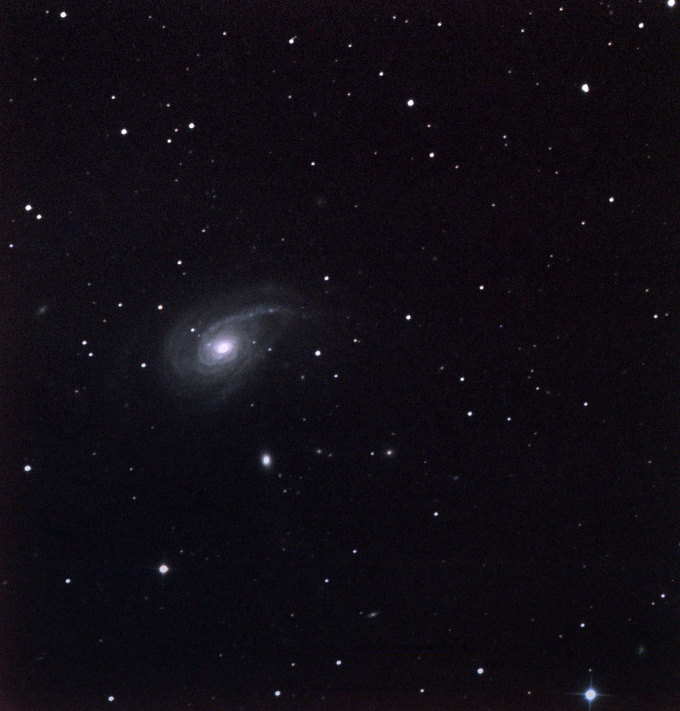
Distorted Arp spiral galaxy 78. Photograph by Blake Nancarrow.
Aries is something of a peculiar constellation with the bent line stick figure. Do you see a ram or sheep in those stars?! This constellation does not include a Messier target but offers the morphed Arp 78 or NGC 772, the quadruple star system lambda Arietis, and will also be visited by solar system wanderers. HD 20367 is an interesting star with a spectral class of G0 like our Sun. And it has 1 known exoplanet which is very similar to Jupiter. At magnitude 6.4, you probably can't see it naked eye; it will be easy with binoculars. You can also easily imagine the star surrounded by a solar system not unlike ours. Asteroid 7 Iris is moving slowing through Aries.
For a challenge, try viewing the Fornax constellation. Its stick figure is often shown as a single straight line. While low in the southern sky, it does fully climb above the horizon. To be clear, the constellation borders (which define a constellation officially) rise completely above our horizon at this time of year. So, this is the best time to view this infrequently visited area. Look down and right of Orion. The furnace is surrounded by the winding Eridanus stars and just above Acamar aka theta Eri. If you can punch through the thick atmosphere, you might see Arp 77 with NGC 1097 prime and A. You may have better luck with the wide double LDS 93 aka HD 20782 and HD 20781. Try for planetary nebula NGC 1360 (with and without your O-III filter). Curiously, asteroid (2) Pallas is moving from east to west in Fornax.
Like going low? Did you know that Columba, the dove, also rises completely above our southwestern Ontario horizon? It will be very low, lower than Fornax. It can be found down and right of Canis Major. The alpha and beta stars are brighter than mag 3.5 so should be visible, if not too murky. mu Columbae, the runaway star ejected from iota Orionis system, at magnitude of 5.2 may be extincted in the thick air. But if you tag it, it is one of the rare O-class stars that can be seen with the naked eye.
Canada in space!
Next week, the Canadian Space Summit is taking place in Ottawa. Then in early December, also in the Nation's Capital, is the Dream Chaser event. See the Canadian Space Agency web site for more information.
The international space station (ISS) will resume an evening phase beginning 26 Nov. Watch the bright point of light silently fly overheard after sunset. See the Heavens-Above web site for dates and times for the ISS and other nearby satellites and human spacecraft.
racing into space
Planned for 27 Nov, the Space X company is going "uphill" to ISS to replenish supplies. Elon Musk's aerospace company has been quite busy this year with about one rocket launch per month. They continue to successfully recover their stage 1 rocket engines, on land and at sea, dramatically reducing the costs to their clients. They are one of the amazing entrants in the new space race...
Orbital ATK launched the S.S. Gene Cernan vessel which will dock with the ISS. The "hand" on the Canadarm was recently repaired.
Did you know that humans left the Moon on 13 Dec 1972?
Did you know Australia launched WRESAT on 29 Nov 1967? The Weapons Research Establishment Satellite reached orbit atop a donated Sparta upper stage rocket. The battery-powered conical satellite orbited the Earth over 600 times and returned data from its first 70 trips. Australia was the seventh country to reach space. Back in September 2017, it was announced that the Aussie government will create a formal space agency.
Keep tabs on human space flight and related activities at spaceflightnow.com.
celestial events
Here's your quick summary of the interesting astronomical events for the next few weeks.
November 2017
- 16 & 17 - Moon near Venus & Jupiter
- 17 - early morning, spot a very old Moon?
- 17 - Leonid meteors peak
- 18 - new Moon
- 19 & 20 - spot a very young Moon?
- 21 - Mercury, Saturn, Moon in a line
- 22 - Neptune stationary
- 23 - Mercury
- 25 - Lunar X
- 26 - Lunar Straight Wall
December 2017
- 4 - Geminid meteor shower starts
- 10 - good night to see moon(s) of Uranus
- 13 - Geminid meteor shower peak
RASC events
Nov '17
- 20 thru 23 - dark sky observing window, first clear night
- 21 - NOVA course continues
- 27 thru 30 - city sky observing window, first clear night
- 29 - RASC annual meeting (please attend)
Dec '17
- 1 - happy birthday RASC!
- 2 - solar observing window
- 13 - next RAN meeting
thanks
Blake uses a variety of tools and products to assemble his presentation and article, including the SkyTools, Stellarium, and OccultWatcher software. Thanks to SMU for the telescope time.
Information and imagery was provided by David Mitsky, Ron Baalke, Ralph Chou, Malcolm Park, Michael Watson, Chris Vaughan, and Guy Nason. Blake thanks Rhonda Gribbon for her support.
§
Be seeing you. Contact Blake Nancarrow (astronomy at computer-ease dot com) for errors, omissions, questions.

